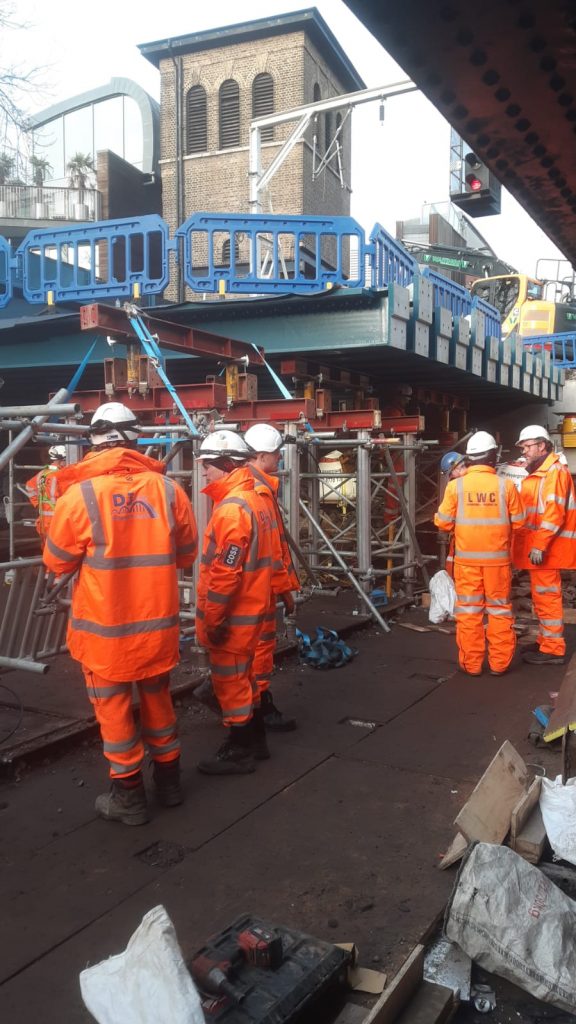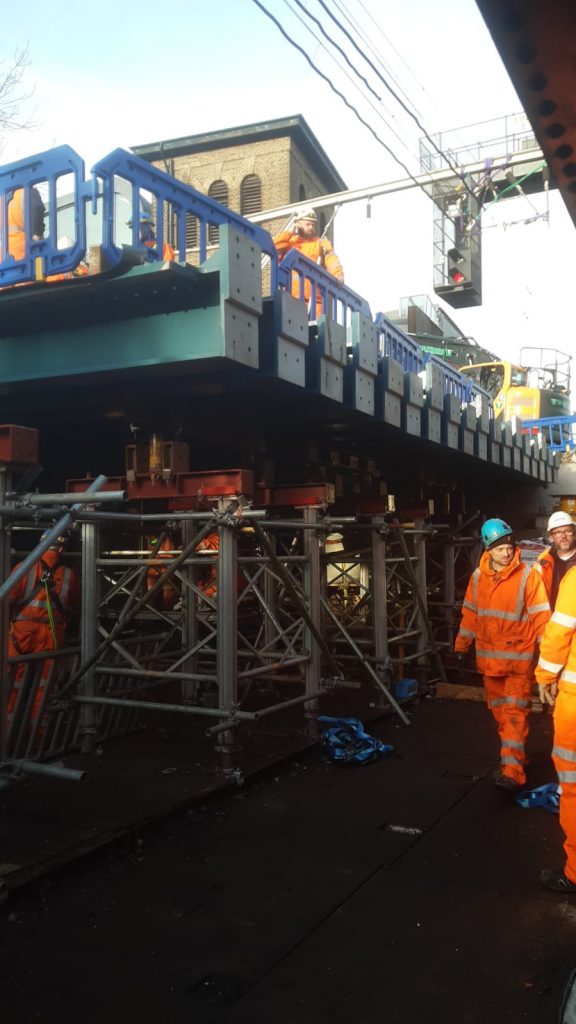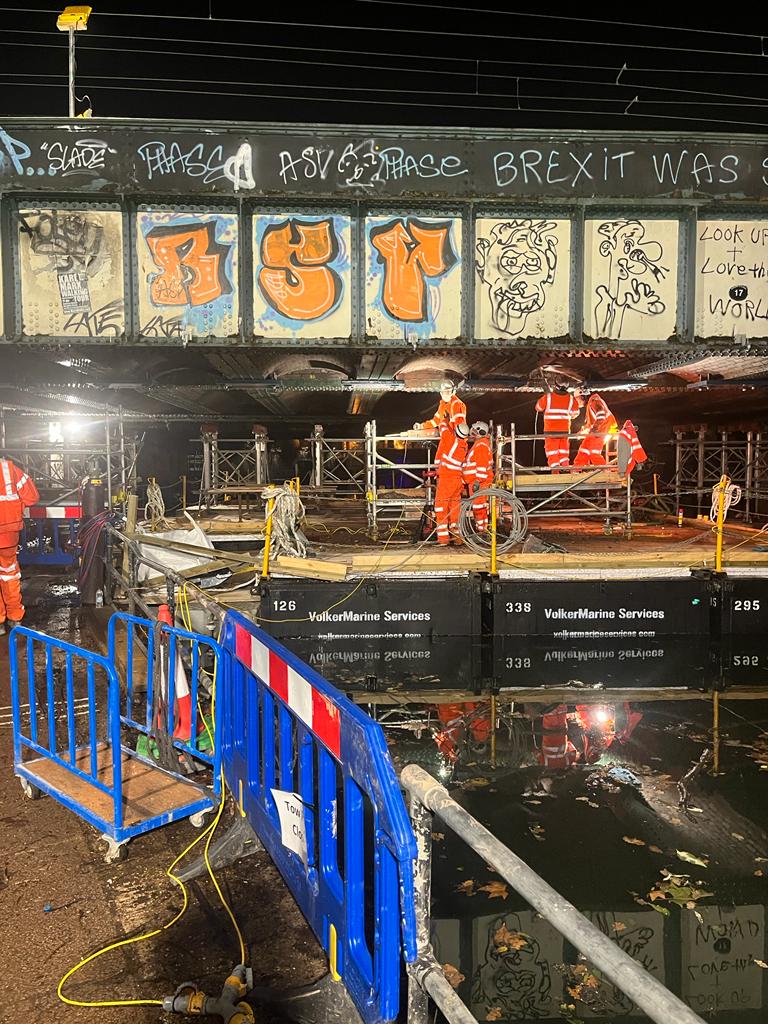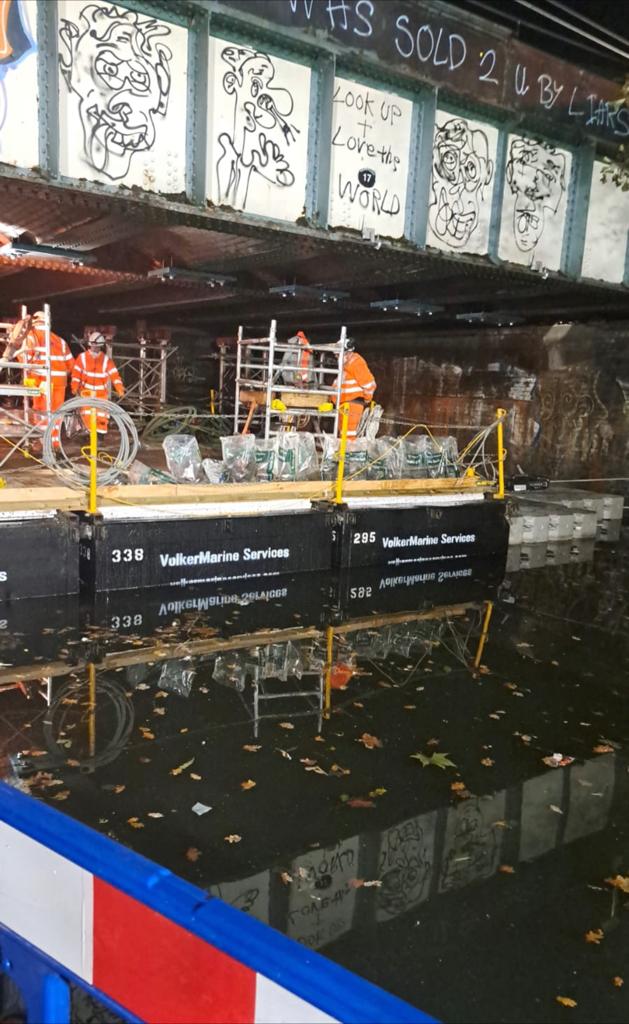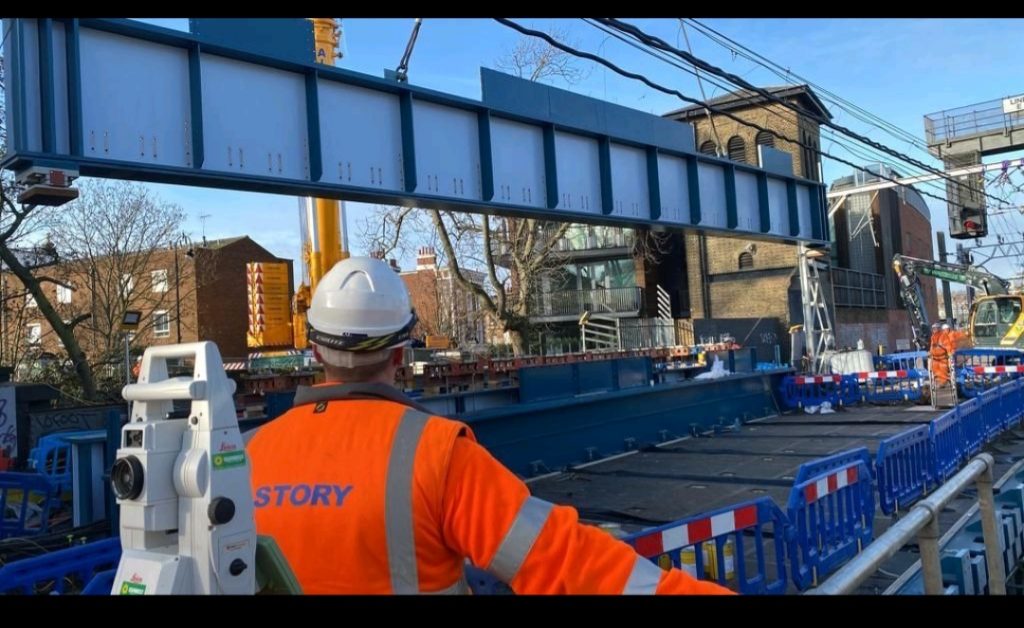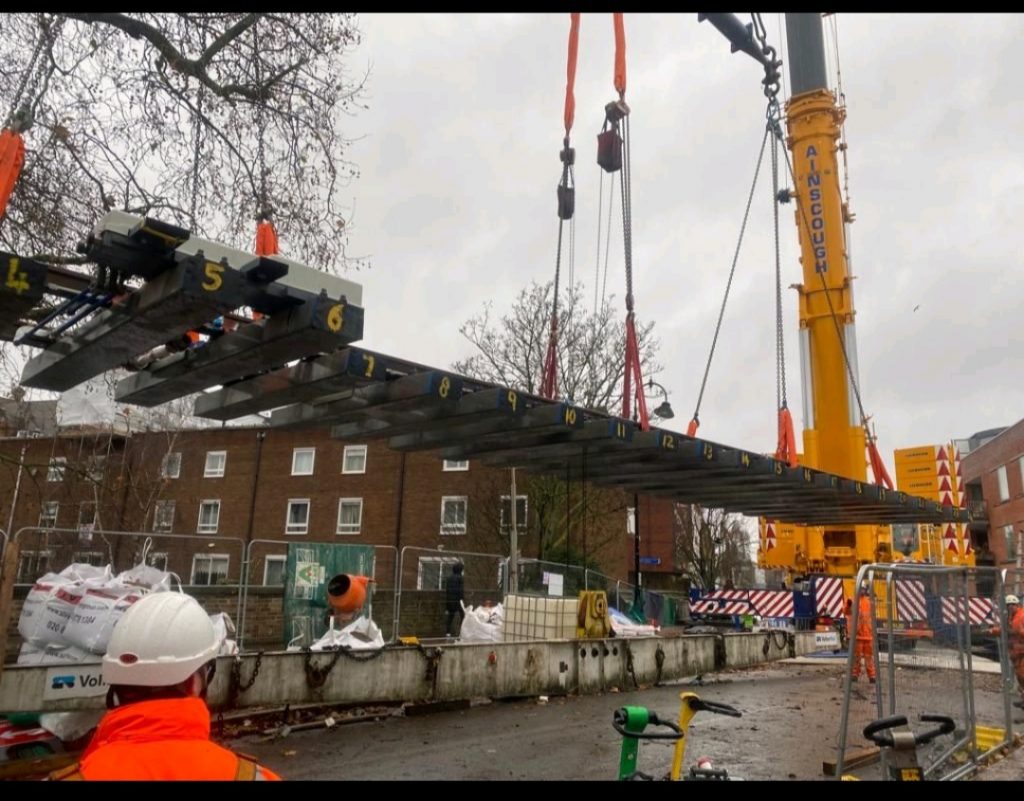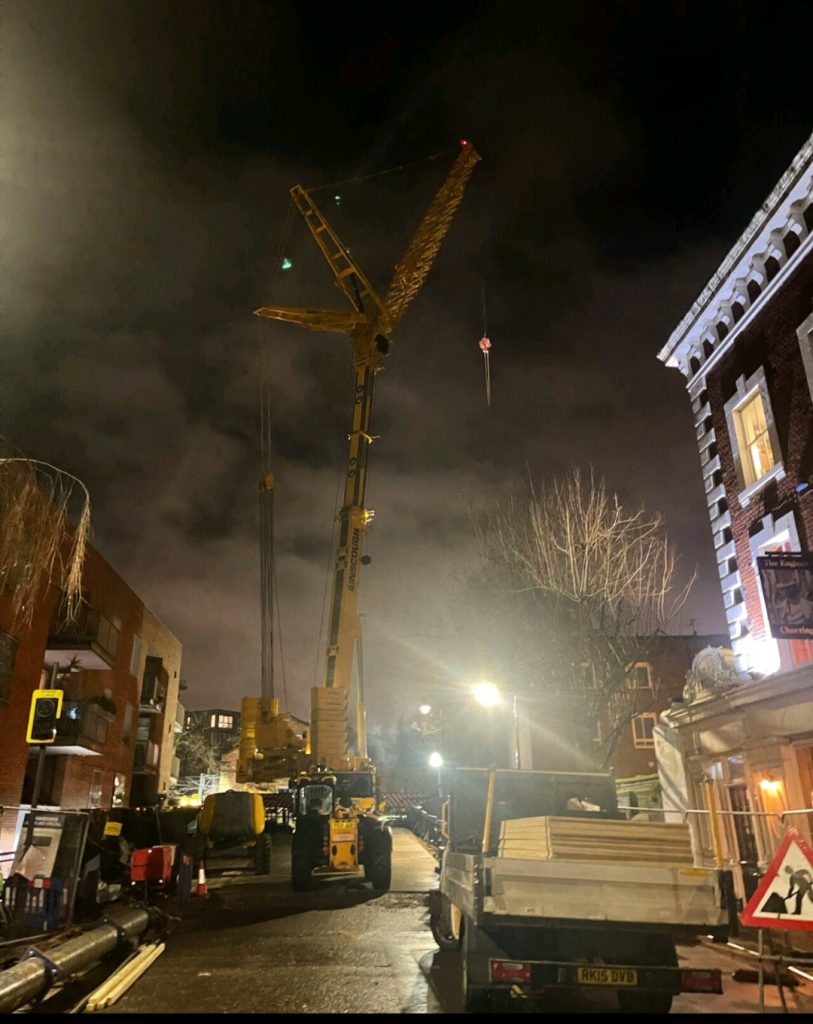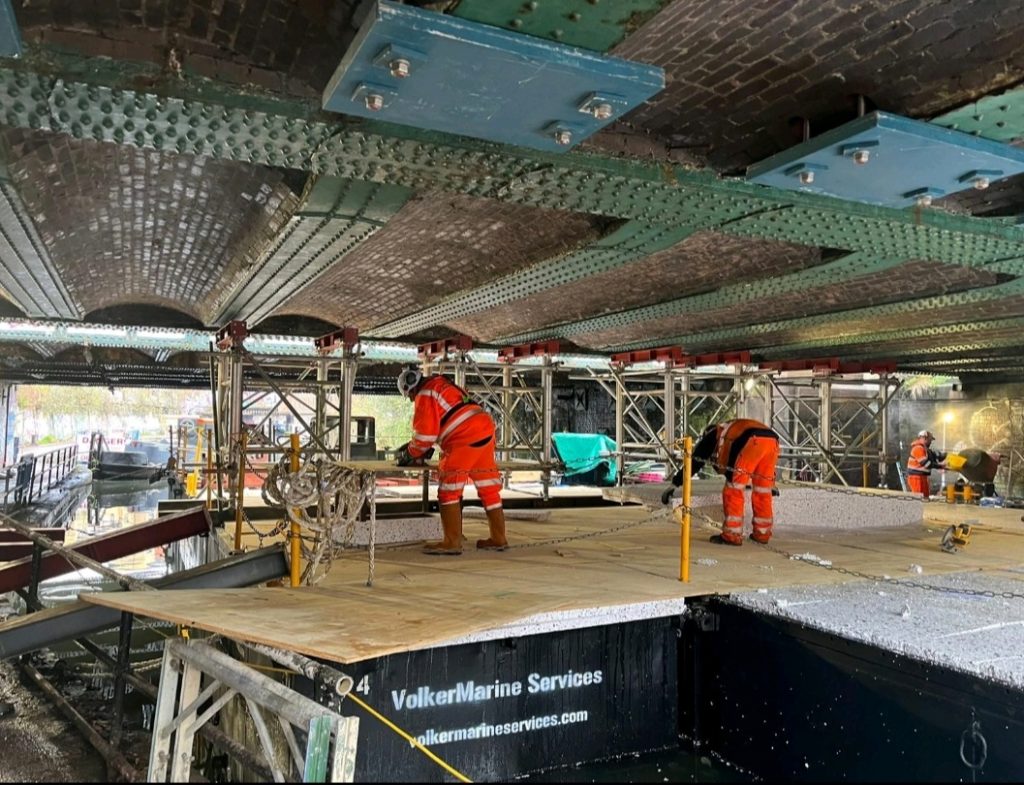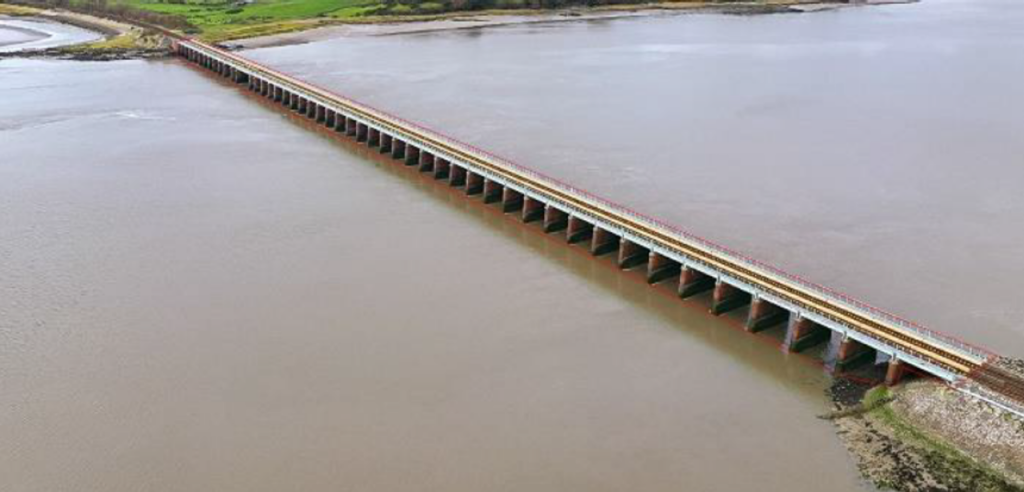Regents Canal, Camden Rail Bridge Replacement Bridge Support

Project Value:
£315kDates:
December 2022 – January 2023Overview
GPS Marine and Civil Services (GPS MACS) provided marine support to Story Contracting during the possession and replacement of the Camden rail bridge over Christmas 2022.
The scope of work included constructing a solid pontoon deck across the width of the Regents Canal. The barges were fitted with a crash deck to allow the demolition teams safe access to the underside of the bridge and ensure no waste from the demolition went into the waterways.
During the constructive stage the pontoon was used to support the entire weight of the new bridge planks and jack into position for the securing of the final deck beam.
As part of the works GPS MACS undertook detailed stability calculations to account for the movement of the barge during the uneven loading of the bridge planks. With the barge expected to drop over 200mm during loading and only a limited run on the jacks these calculations were essential to the timely reconstruction of the bridge.
Upon loading of bridge planks, the barge behaved as GPS MACS calculated and all the planks aligned allowing for the Story team to lift in the final section using the 650t land-based crane.
GPS operatives worked 24 hours during the possession in support of the project, maintaining barge stability levels by ballasting in line with the stability calculations. This work allowed the barge works to complete on schedule and Story to successfully hand back the bridge to Network Rail on time.
- Enabling Works
- Pre-construction canal bathymetry survey
- Detailed pontoon loading calculations including under up to 30t demo waste and during the support of the new bridge under loading.
- Marine Works
- Assembly of pontoon system in adjacent basin and transfer and secure in place
- Provide safe access platform to the underside of the bridge for demolition teams
- Manage ballast levels to ensure barge stability is within calculated limits before and during demolition.
- Mange ballast levels to ensure barge stability during the bridge construction allowing for exact alignment of all bridge panels.
Design
- Detailed barge behaviour analysis under variation of loads
Construction
- Complete construction of the full scope of works
Project Management
- Coordination with multiple contractors on a high time constrained job in a high visibility location
Engineering
- Stability analysis for the barges
- Deck loading analysis for the barges
Marine Logistics
- Planned, supervised, and carried out mobilisation of all marine plant to site.
Utilised the following key sites for supporting the project:
- Powerdays, Wilsden
- Camden, Regents Canal
Other Projects
Nearshore / Inland Warerways
Working on a high traffic high visibility site in the centre of Camden Central London.
Health and Safety
Provided a solid platform to allow demolition teams to erect scaffold to work on the underside of the rail bridge during demolition, massively reduced risk of from working from a canal barge at height .
Environmental
System allowed for zero demo waste into the canal
Innovation
Original temporary works designers explored the use of barges to support the bridge, but were unable to achieve adequate stability and levels for jacking. GPS MACS able to achieve excellent stability due to the calculated redistribution of ballast across the pontoon system, allowing for maintained levels even during uneven loading.

Project Value:
£315kDates:
December 2022 – January 2023*Mobile Row*
Overview
GPS Marine and Civil Services (GPS MACS) provided marine support to Story Contracting during the possession and replacement of the Camden rail bridge over Christmas 2022.
The scope of work included constructing a solid pontoon deck across the width of the Regents Canal. The barges were fitted with a crash deck to allow the demolition teams safe access to the underside of the bridge and ensure no waste from the demolition went into the waterways.
During the constructive stage the pontoon was used to support the entire weight of the new bridge planks and jack into position for the securing of the final deck beam.
As part of the works GPS MACS undertook detailed stability calculations to account for the movement of the barge during the uneven loading of the bridge planks. With the barge expected to drop over 200mm during loading and only a limited run on the jacks these calculations were essential to the timely reconstruction of the bridge.
Upon loading of bridge planks, the barge behaved as GPS MACS calculated and all the planks aligned allowing for the Story team to lift in the final section using the 650t land-based crane.
GPS operatives worked 24 hours during the possession in support of the project, maintaining barge stability levels by ballasting in line with the stability calculations. This work allowed the barge works to complete on schedule and Story to successfully hand back the bridge to Network Rail on time.
- Enabling Works
- Pre-construction canal bathymetry survey
- Detailed pontoon loading calculations including under up to 30t demo waste and during the support of the new bridge under loading.
- Marine Works
- Assembly of pontoon system in adjacent basin and transfer and secure in place
- Provide safe access platform to the underside of the bridge for demolition teams
- Manage ballast levels to ensure barge stability is within calculated limits before and during demolition.
- Mange ballast levels to ensure barge stability during the bridge construction allowing for exact alignment of all bridge panels.
Design
- Detailed barge behaviour analysis under variation of loads
Construction
- Complete construction of the full scope of works
Project Management
- Coordination with multiple contractors on a high time constrained job in a high visibility location
Engineering
- Stability analysis for the barges
- Deck loading analysis for the barges
Marine Logistics
- Planned, supervised, and carried out mobilisation of all marine plant to site.
Utilised the following key sites for supporting the project:
- Powerdays, Wilsden
- Camden, Regents Canal
Nearshore / Inland Warerways
Working on a high traffic high visibility site in the centre of Camden Central London.
Health and Safety
Provided a solid platform to allow demolition teams to erect scaffold to work on the underside of the rail bridge during demolition, massively reduced risk of from working from a canal barge at height .
Environmental
System allowed for zero demo waste into the canal
Innovation
Original temporary works designers explored the use of barges to support the bridge, but were unable to achieve adequate stability and levels for jacking. GPS MACS able to achieve excellent stability due to the calculated redistribution of ballast across the pontoon system, allowing for maintained levels even during uneven loading.


